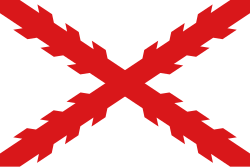
Back حرب الملكة آن Arabic Kraliça Anna müharibəsi Azerbaijani Война на кралица Ан Bulgarian Guerra de la Reina Anna Catalan Válka královny Anny Czech Dronning Annes Krig Danish Queen Anne’s War German Guerra de la reina Ana Spanish Kuningatar Annan sota Finnish Deuxième guerre intercoloniale French
| Queen Anne's War | ||||||||||
|---|---|---|---|---|---|---|---|---|---|---|
| Part of the War of the Spanish Succession and the Indian Wars | ||||||||||
 Map of European colonies in America, 1702 | ||||||||||
| ||||||||||
| Belligerents | ||||||||||
|
Caughnawaga Mohawk Choctaw Timucua Apalachee Natchez |
Chickasaw Yamasee | Iroquois Confederacy | ||||||||
| Commanders and leaders | ||||||||||
|
José de Zúñiga y la Cerda Daniel d'Auger de Subercase Philippe de Rigaud Vaudreuil Father Sebastian Rale Jean-Baptiste Hertel de Rouville |
Joseph Dudley James Moore Francis Nicholson Hovenden Walker Benjamin Church | Teganissorens | ||||||||
Queen Anne's War (1702–1713) or the Third Indian War[1] was the second in a series of French and Indian Wars fought in North America involving the colonial empires of Great Britain, France, and Spain; it took place during the reign of Anne, Queen of Great Britain. In the United States, it is often studied as a standalone conflict under this name, although it is also viewed as the American theater of the War of the Spanish Succession. In France, it was known as the Second Intercolonial War.[2]
The war was primarily a conflict between French, Spanish and English colonial ambitions for control of the North American continent while the War of the Spanish Succession was being fought in Europe. Each side drew in various Indigenous communities as allies, and it was fought on four fronts.
In the south, Spanish Florida and the English Province of Carolina attacked one another, and English colonists engaged French colonists based at Fort Louis de la Louisiane (near present-day Mobile, Alabama), with Indigenous bands allied on each side. The southern war did not result in significant territorial changes, but it resulted in seriously decimating the Indigenous population of Spanish Florida and parts of southern Georgia, with destruction of the network of Spanish missions in Florida.
In New England, English colonists and Indigenous allies fought against French colonists and their Indigenous forces, especially in Acadia and unsettled border frontier with Canada. Quebec City was repeatedly targeted by British colonial expeditions, and the British captured in 1710 the Acadian capital Port Royal. French colonists and the Wabanaki Confederacy sought to thwart British expansion into Acadia, whose border New France defined as the Kennebec River in what is now southern Maine.[3] They executed raids in the Province of Massachusetts Bay (including Maine), most famously the Raid on Deerfield in 1704 and one on Groton in 1707, in both cases taking numerous captives to Montreal and Kahnawake (a Mohawk mission village) for ransom or adoption by Mohawk families.
In Newfoundland, English colonists based at St. John's disputed control of the island with the French colonists of Plaisance, present-day Placentia. Most of the conflict consisted of economically destructive raids on settlements. The French colonists successfully captured St. John's in 1709, but the British colonists quickly reoccupied it after the French abandoned it.
French privateers based in Acadia and Plaisance captured many ships from New England's fishing and shipping industries. Privateers took 102 prizes into Plaisance, second only to Martinique in France's American colonies. The naval conflict ended with the British capture of Acadia (Nova Scotia).[4][5]
The Treaty of Utrecht ended the war in 1713, following a preliminary peace in 1712. France ceded the territories of Hudson Bay, Acadia, and Newfoundland to Britain while retaining Cape Breton Island and other islands in the Gulf of St. Lawrence. Some terms were ambiguous in the treaty, and the concerns of various Indigenous communities were not included, thereby setting the stage for future conflicts.
- ^ The first Indian War was King Philip's War, the second was King William's War, and the fourth was Father Rale's War. See Alan Taylor, Writing Early American History, University of Pennsylvania Press, 2005, p. 74.
- ^ Denis Héroux, Robert Lahaise, Noël Vallerand, La Nouvelle-France, p. 101 [1]
- ^ William Williamson. The History of the State of Maine. Vol. 2. 1832. p. 27; Griffiths (2005), p. 61; Campbell, Gary. The Road to Canada: The Grand Communications Route from Saint John to Quebec. Goose Lane Editions and The New Brunswick Heritage Military Project. 2005. p. 21.
- ^ Donald F. Chard, "The Impact of French Privateering on New England, 1689–1713." American Neptune 35.3 (1975): 153–65.
- ^ Nicolas Landry, "Les activités de course dans un port colonial français: Plaisance, Terre-Neuve, durant la guerre de Succession d'Espagne, 1702–1713." Acadiensis 34.1 (2004): 56–79. online
© MMXXIII Rich X Search. We shall prevail. All rights reserved. Rich X Search
